During the second half of 2020 Germany will lead the one of the two EU
Battle Groups (EUBG) which is kept on standby for a rapid deployment.
The EUBG is made up of around 1.500 military personnel from Austria,
Czech Republic, Croatia, Germany and The Netherlands. The main element
of the EUBG will be provided by Germany and The Netherlands with units
from the DSK and 11 infantry battalion. Exercise
Falcon Autumn provided the opportunity for the German and Dutch
battalions to train all aspects of air mobile operations together.
During the media day held on October 5 major Mark 11LMB planning officer
and major Ronald “Wally” from the DHC provided an insight into Falcon
Autumn. First Maj. Mark explained the training cycle of 11LMB. “We
organize two large exercise a year with one held in spring and one held
in the autumn keeping into account the weather conditions for the
helicopter operations. These are planned one year in advance and provide
for an overlap in the planning and execution of the exercise.
Preparation of these exercises start a year prior to its execution.
Furthermore, we look into the availability of our battalions and
companies as some (parts) of them are away”. Members of 11LMB are
currently deployed to support UN operation MINUSMA in Mali. The mission
will be ended from May 1, 2019 with all Dutch deployed personnel
returning home.
The Falcon Autumn scenario was split into three phases. Maj. Mark
explains. “The first week was used for the arrival of the helicopters.
From Wednesday the exercise aimed at getting everyone
acquainted and to train each other’s procedures.
During the second week of the exercise training was conducted on company
level and aimed at the several different Air Assault missions. During
the third week a battalion (sized 800 – 1.000 personnel) will be trained
in one large action using all techniques and procedures trained during
the first phases”. Several
missions were conducted twice with for instance on the first day actions
by the German companies and the other day the same scenario executed by
the Dutch companies. It showed a difference in between the both
countries as the Germans are using dogs to support their actions for
instance during a RAID. “During Falcon Autumn our 11 infantry battalion
with its staff companies were trained and they were supported by our
engineering, maintenance, medical, supply companies and the pathfinder
platoon. The German 31 regiment provides the headquarter for the German
battalion with 26 parachute regiment deployed for the exercise.” The DSK
deployed with its THR 30 who brought eight NH90-TTH including two
spares, the DHC provided eight Apaches and five Chinooks, including two
and one spares respectively.
Maj. Ronald “Wally” explained the participation of the Gilze-Rijen based
squadrons.
“Our helicopters are an expensive and scarce resource which also require
a lot of maintenance. Except working together with our 11LMB colleagues
we also work together with the special forces of the RNLA and the
marines of the RNN. Basically our helicopters are requested five to six
time more then we can deliver. Therefore we look into what we can
support and make sure that we are totally prepared and trained. During
this exercise we are working together with the German NH90s which is
both interesting and instructive”. The DHC 7 and 860 squadrons are
equipped with the naval version NH90-NFH which can be used to support
land forces but are predominantly used on the RNN vessels and other
maritime tasking.” Asked about things encountered during the exercise
with the NH90-TTHs “Wally” addressed three items. “With our 11 AMB
concept we are running a little ahead of our German colleagues. We
encountered two items in the previous days. One related to the use of
command communication in English which was sometimes done in German.
Another item revealed the use of different calls made by the helicopter
crews. For instance during the scenario’s we used flares to simulate
heat seeking missiles. The procedures used between the German and Dutch
helicopter crews were different and in these cases it’s important to use
the same calls to quickly respond to these treats. We went into the
training manuals and checked all procedures. For this and the other
items we encountered we jointly adapted and changes were made into both
the Dutch and German manuals. As a result we saw an learning curve for
all participants”.
During Falcon Autumn all aspects of Air Assault missions (Air Attack,
Air Assault, Air Drop/Landing and Air Raid) were conducted. An Air
Attack is conducted by the attack helicopters tasked to destroy enemy
targets, an Air Raid will see a quick action by an infantry company
inserted by transport and protected by attack helicopters. Air assault
will see an operation to establish a bridgehead deep into enemy
territory and the continued operation by the helicopters. Air landing is
done by either the landing by a transport aircraft on a dirt strip or
transport helicopters on landing zones. Air drops are made from
transport aircraft with either paratroopers or cargo being dropped over
a landing zone.
The combined DVI / Media day was set in the afternoon where actions
could be observed of the actual scenario’s planned for that day. First
to arrive was a team of pathfinders , normally operating in a team of
six persons, dropped by a 336 squadron C-130H.30 The pathfinders mission
is to check for suitable landing zones for either the transport aircraft
or helicopters .These zones will be marked for the aircrews with landing
lanes split for the medium and heavy transport helicopters. Pathfinders
can jump with an additional person – tandem jump - which is used to
insert a non paratrooper like a doctor or technician. Immediately after
their ‘preparation’ jump the pathfinders were transported back to
Eindhoven AB to prepare for their jump in the dark at the Maarnewaard
marking the start of the final week of Falcon Autumn. There they were to
survive for 72 hours before the first elements of the Dutch / German
battalion would arrive. Important during operations in enemy territory
is the supply of the ground forces by cargo drops by transport aircraft.
The Dutch Hercules returned to perform two cargo drops using its Cargo
Delivery System (CDS).
CDS is a relatively new task for the squadron and within the Netherlands
it can only trained at MLT Deelen due to its available size and safety
regulations.
Between the two drops three Apaches departed heading towards military
training complex ‘De Vlasakkers’ near Amersfoort.
The previous day companies were inserted to conduct an Air Assault and
these forces were retracted by four NH90s and four CH-47Ds with the
Apaches providing cover.
During the recovery at MLT Deelen the next wave of soldiers were already
in formation to board the helicopters to conduct their assigned tasks.
From Monday until Wednesday all training received during phases 1 and 2
could be put into practice in the exercise final which saw the
helicopters use a Forward Arming and Refuelling Point at the TT circuit
in Assen supporting the battalion size Air Assault at the Maarnewaard. |
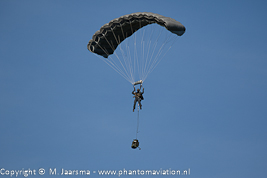 |
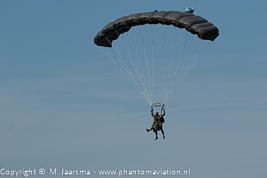 |
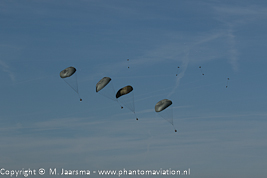 |
|
Pathfinders jumping from the Hercules |
to prepare the drop and landing zone(s). |
CDS drop over Deelen by the C-130. |
|
|
|
|
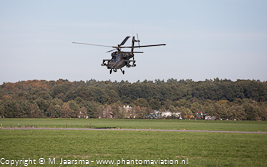 |
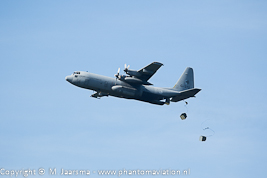 |
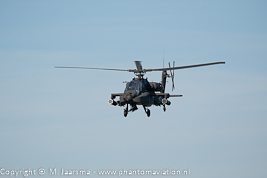 |
|
Apache leaving to meet his colleagues. |
The Hercules cleared for another drop. |
Apaches arrived first at the landing zone |
|
|
|
|
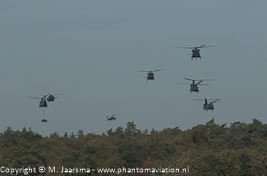 |
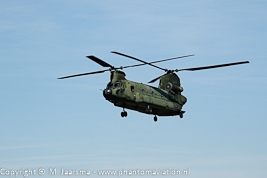 |
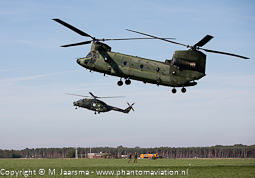 |
|
to protect the 'transport package' |
who extracted ground forces after |
completing a mission near Amersfoort |
|
|
|
|
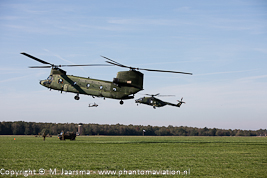 |
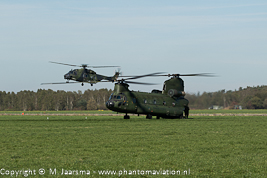 |
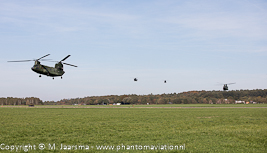 |
|
Chinook and NH90 using the "lanes" marked by the pathfinders. |
these are set by helicopter type (medium or heavy lift) |
and enables the safe boarding by ground forces. |
|
|
|
|
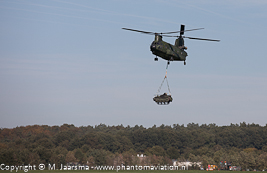 |
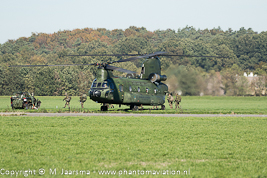 |
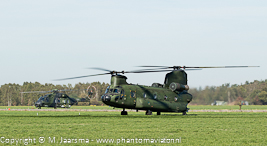 |
|
A German army Wiesel light armoured fighting vehicle. |
Ground crews working on a Chinook after its return from a mission. |
Chinook and NH90 on the ground waiting for the next group of soldiers. |
|
|
|
|
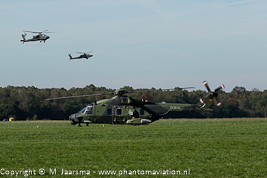 |
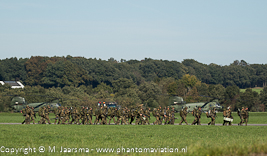 |
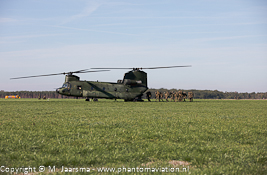 |
|
Apaches providing cover while the |
transport helicopters are on the ground |
disembarking and boarding the soldiers |
|
|
|
|
 |
|
|
|
from DSK and 11 LMB) |
|
|





















